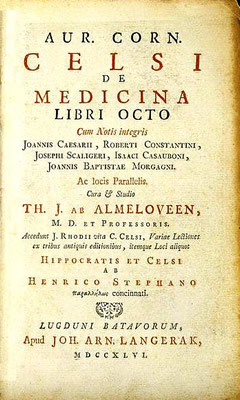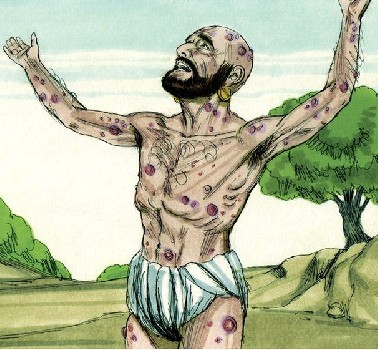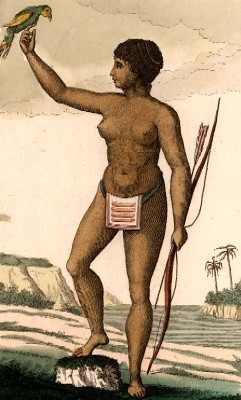
Venereal Disease Treatment Menu: 1 2 3 4 5 6 7 8 9 10 11 12 13 14 Next>>
Venereal Diseases in the Golden Age of Piracy, Page 3
The History of VD
"For no doubt it reaches in Antiquity the First Ages; it being irrational either to suppose a World drowned for their Sins, Strangers to the Vice that contracts it, or that their Wickedness any more than ours deserved Exemption." (John Atkins, Lues Venerea, p. 1)
History is sometimes a murky thing; the farther back you go, the murkier it seems to be. This is particularly true for for topics which are spoken of in embarrassed, hushed whispers such as venereal diseases. This is further complicated by the Universal Source Theory which suggested that all the known venereal diseases were essentially stages of the same disease. And yet, if there were anything that would point to the fact that gonorrhea and syphilis were two completely separate phenomenon, it was their history.

Photo: Zoran Kurelić Rabko
"Leper's Show", Reenactment in Croatia (OF COURSE there are
People Who Re-enact Leper Colonies.)
Symptoms of gonorrhea, chancroid and certain other venereal diseases seem to have been reported in ancient Euro-Asian records, while those of syphilis do not seem to have occurred before 1494 when Europeans began visiting the New World. (This cannot be completely verified - there are historians who insist that syphilis existed before 1494. The hushed tones with which such diseases are discussed and recorded in ancient documents and its chameleon-like ability to display symptoms similar to other diseases give such a basis to this.)
It doesn't help that the potential pre-Columbus descriptions of syphilis are vague. Contemporary sea surgeon John Atkins, who firmly believed that Venereal Diseases were ancient, noted "We find Moses describing a Leprosy, Levit. 13 and 14, that corresponds with the Symptoms, and seems to have been a Species of this Distemper; so does the Difficulty of the Cure, Deut. 28. where it is said, The botch and scab of Egypt of which thou canst not be healed"1. He adds, "The same may be said of many Ancient Physical Authors, who with the like or greater Plainness have described the Symptoms, tho' not under the modern Titles."2 The difficulty in identifying these diseases from such vague citations is readily apparent.
Still, there are suggestions of a variety of different venereal diseases rampant in history, and modern historians, not under the burden of believing all of venereal problems were stages of the same thing have taken some trouble to tease references to the problem out of the ancient texts and construct a history, albeit an inexact one. As modern historian Charles Camblos Norris puts it, "Although there are no means at our command of positively identifying gonorrhea in the early ages, it is almost certain that the disease can be traced back to the earliest records of the human race, its progress through the generations having left in its wake a blind, halt, maimed, sterile, and sexless multitude."3 Let's look briefly at the histories of the two venereal diseases most discussed by medical men during the golden age of piracy: gonorrhea and syphilis.
1,2 John Atkins, Lues Venerea, p. 2; 3 Charles Camblos Norris, Gonorrhea in women, 1913, p. 17
The History of VD: Gonorrhea
Galen gave gonorrhea its name. One of the primary symptoms of the disease is the discharge of serum from the sex organ. Based on this, Galen explains in his treatise De locis affectis, "The term gonorrhia is evidently derived from gonos [seed] and rhein [to flow].1

Galen of Pergamon, From De Morbo Attonito Liber
Unus,
By Justus Cortnumm (1677)
The name coined by Galen recalls this symptom, suggesting that the disease creates an uncontrollable flow of semen from the urethra. The vulgar term "clap" came later, appearing as early as 1378.2 Eighteenth century author François Swediaur suggested the term was adopted by the English, "from the old French word clapiers, which meant certain fixed places in different quarters of a town, kept and inhabited by public prostitutes, as is still seen in some of the great towns in Italy."3 Historian Paul Lacroix expands upon this, noting that such places were called "clapiers (hutches), claperii, for the reason that the daughters of joy hid themselves in them like rabbits, cuniculi (in old French conins), in their holes."4 Lacroix delves deeply into the etymology of the word clapier in association with rabbits, suggesting that the clapping sound a rabbit trap makes when sprung may have something to do with the name.
Some of the more 'ancient' physicians, men who were still revered by medical men in the 17th and early 18th century, also mention symptoms that could have been gonorrheal. The Greek physician Hippocrates (c. 460 – c. 370 BC) talks about strangury (difficulty and pain when urinating), which some authors suggest is indicative of venereal diseases. "It seems he called acute gonorrhea "strangury", thought it was caused by indulgence in the pleasure of Venus [sex], described vaginal discharge – "leucorrhoea" (fluxus [a white or yellow discharge from the vagina]) – in women... and distinguished different types: albus [white], rufus [rufous - reddish-brown], ruber [red], and niger [black]."5 However, while an examination of Hippocrates' texts does note outflows of colored urine which could suggest gonorrhea, it would be difficult to say that they are definitely so.6
Historian Charles Norris suggests that Aulus Cornelius Celsus (c. 25 B.C. – c. 50 A.D.)

Celsus' De Medicina (1746)
discussed venereal diseases noting a "purulent or bloody discharge" from the urethra as well as inflammation of the testicles.7 However, the actual description does not sound much like gonorrhea. Celsus says that when the "urine drops away slowly, or if blood is discharged with it, and in that some bloody concretions, and it is made with difficulty, and the internal parts
about the pubes are pained, the fault is in the bladder."8 He goes on to suggest bladder stones are the cause. Celsus also discusses ulcers in the urethra in connection with phimosis9 - the inability to withdraw the foreskin from the penis. This may explain why early eighteenth century sea Physician William Cockburn associates the condition with gonorrhea as we shall see in the discussion of curing that disease. However, most of Celsus' comments on venereal problems do not appear to suggest true gonorrhea.
Historian Norris mentions numerous other early sources referring to diseases that could be gonorrhea, but which are not called by that name. These include several vague biblical citations such as those Atkins mentioned, proceeding to more specific descriptions that follow the progress of advancing medicinal knowledge. For example, he says that Jewish philosopher and physician Maimonides of Cordoba (1135-1204) described urethritis being when "fluid escapes without erection and without a feeling of pleasure; the appearance of the discharge is similar to that of barley dough dissolved in water or coagulated albumin, and is the result of an internal disease; it is essentially different from the seminal fluid and mucus, the latter being more homogeneous."10 This sounds very much like gonorrhea. Maimonides further notes that the cause of this problem include "amorousness and excesses of various kinds."11
Norris cites several other 10th and 11th century Arabian physicians and continues on to writings by several physicians and scholars from the middle ages in Europe.12 While interesting and at times clearly pointing to some venereal problem, like so many of the preceding comments, it cannot be definitely said that these sources refer to gonorrhea. Still, amidst the muddle of such descriptions, the thread of gonorrhea occasionally appears, making it appear that the disease was flourishing long before syphilis arrived on the European and Asian continents.
1 Aelius Galenus, Galen on the affected parts, translated by Rudolph E. Siegel, Book 6, Cap. 6, 1976, p. 192; 2 Gonorrhea historical prespective, edited by C. Michael Gibson, Sara Mehrsefat & Priyamvada Singh, Wikidoc, gathered 3/23/18; 3 François Xavier Swediaur, A Comprehensive Treatise Upon the Symptoms, Consequences, Nature and Treatment of Venereal, or Syphilitic, Diseases, Vol. 1, Translated from the 7th Edition, 1819, p. 113-4; 4 Paul Lacroix, History of Prostitution, Vol. 2, 1926, p. 307; 5 Franjo Gruber et al, "History of Venereal Diseases from Antiquity to the Renaissance", Acta Dermatovenerologica Croatica, 2015; 23(1), p. 3-4; 6 For example, see Hippocrates and Galen, Translated by John Redman Cox, 1846, p. 330; 7 Charles Camblos Norris, Gonorrhea in women, 1913, p. 18; 8 Aulus Cornelius Celsus, Of Medicine in Eight Books, 1756, p. 61; 9 Celsus, p. 366-7; 10,11 Norris, p. 18; 11 See Norris, p. 20--2
The History of VD: Syphilis
Syphilis is interesting in that it doesn't appear to exist in the European theater before the very late 15th century, based on contemporary accounts of venereal diseases. (There is some disagreement about this as we shall see.) It was originally named after the place where those who were first 
Artist: Francesco Granacci
French Troops Under Charles VIII Entering Florence on
November 17th 1494 (15th - 16th c.)
infected felt it came. Sea surgeon John Atkins explains that the people who identified the first infection of syphilis at "the Siege of Naples by the French, 1494, thence [started] calling it the French, and sometimes the Neapolitan Disease"1. Blaming syphilis by calling it after the nationality which each infected country felt had brought the disease to them continued to occur well after the Siege of Naples, however.
Each newly affected country lost no time naming the new disease after the neighbour which it suspected, usually with good reason, of having been the source of contamination. The following gives an idea of the variety of names: the Muscovites referred to it as the Polish sickness, the Poles as the German sickness, and the Germans as the French sickness - a term of which the English also approved (French pox) as did the Italians (which presented certain difficulties). The Flemish and Dutch called it 'the Spanish sickness', as did the inhabitants of North-west Africa. The Portuguese called it 'the Castillian sickness', whilst the Japanese and the peoples of the East Indies came to call it 'the Portuguese sickness'. Only the Spanish, oddly enough, did not call it anything.2
In addition to giving the problem such derogatory labels, syphilis managed to acquire some other, less xenophobic names. In 1527, physician Jacques de Bethencourt suggested that the disease "should be named after its cause, and is the first to use the term 'venereal sickness' (morbus venereus)."3 Although this term could fittingly be applied to any of several venereal diseases, under the Universal Source theory, it neatly fit the chancroid/gonorrhea/syphilis progression.
Its popular name was 'the pox', which is what is was called all through the golden age of piracy. This cognomen was apparently given to the disease by Jean Molinet, chronicler and
historian to the house of Burgundy. Molinet, no fan of the French, explained in that in his 1494 battle at Burgundy, King Charles VIII "conquered the great pox, a violent, hideous and abominable sickness by which he was harrowed; and several of his number, who returned

Artist: Christoph Schwartz
Girolamo Fracastoro Warning the Shepherd Syphilis & Hunter Ilceus (1588)
to France, were most painfully afflicted by it... some called it 'les grosses pocques [the large pox]'"4. Molinet mentions several other names given to the disease, including some which blame the French, but most of these failed to attach themselves in the lasting way which 'pox' did.
The name 'syphilis' was given to the disease by Girolamo Fracastoro in 1530 in his long poem Syphilis sive morbus gallicus ['Syphilis or the French Disease'. They just couldn't give that French thing up.] The poem is about a shepherd named Syphilis who offended the Sun God who punished him with the illness. "Thus the name syphilis was born, though it was practically abandoned until the end of the eighteenth century, doctors and public alike preferring to use the word 'pox'."5
There are basically two competing theories about the origin of syphilis: The Ancient Theory and the American Origin Theory. Both were discussed and debated during the golden age of piracy. Before their details can be discussed from a golden age of piracy point-of-view, the way in which medicine was learned must first be understood.
Most of disease prevention and cure theory during the golden age of piracy is based on the writings of the medical authors from ancient Rome and Greece, the 9th - 11th century books of Arabic physicians and the writings from the Italian Schola Medica Salernitana which gathered, translated and expanded upon the Arabic writings into Latin in the 11th - 13th centuries. Many medical men in the Early Modern Era (16th through mid-18th centuries) felt that most of the medical knowledge required could be found in those ancient writings. Venereal diseases presented a unique challenge to this view because they were not well understood by the ancient authors. (The same is true for a broad group of health problems broadly referred to as 'fevers'.) Syphilis has symptoms similar to other diseases, so it was always difficult to positively identify. As a result, some contemporary historians and medical authors believed syphilis was ancient, but it wasn't fully recognized until the late 15th century (The Ancient Theory), while others believe it came from the new world with Columbus and other sailors who visited there (The American Origin Theory).
Historian Claude Quétel explains that proponents of the Ancient Theory of syphilis "relied for their support on ancient texts, beginning with the Bible. They cited the books of Moses (Leviticus),

Artist: Jim Padgett
Job, Covered With Sores as Described in the Bible, Ch 16-1 (1984)
and, more particularly, the account of Job's illness, in which the description of ulcers accompanied by pains in the bones at night seemed to them to be indicative of the pox."6 Curiously, the Book of Job is the most ancient one in the bible, widely believed to be allegorical. However, the graphic depiction of his illness and accompanying sores could easily be fit to some of the symptoms of syphilis. Golden age of piracy sea surgeon John Atkins discusses the origins of the disease, firmly supporting the Ancient Theory of syphilis, striking a decidedly moralistic tone.
For no doubt it reaches in Antiquity the first Ages, and antient as corrupted Nature, it being irrational, either to suppose a World drowned for their Sins, Stranger to the Vice that contracts it, or that their Wickedness any more than our deserved Exemption. No; Providence, we may safely believe, stamped an immediate Punishment on this, as on all other Intemperance and Sin, ab Origine ['from the beginning'], that the Pains and Sufferings succeeding a vicious Course of Life, might, if nothing else would, restrain us to Virtue, and be both a natural and moral Good to us7
A modern explanation of the Ancient Theory is a little more convincing. It suggests that later stages of syphilis which include skin lesions and, eventually, destruction of bones and organs was confused with leprosy. "According to such theories, treponemal infections [caused by spiral-shaped bacteria which are now called spirochetes] (pinta, yaws, endemic, and venereal syphilis) had previously been common, mild, and chronic."8 According to this iteration of the theory, improvement in individual health care and the environment made non-sexual contraction of such diseases less common, preventing people from being infected when young. The result was that "only the hardier, sexually transmitted strains survived in Europe, producing the appearance of a new epidemic diseases [in the late fifteenth century]."9

Artist: John Vanderlyn
Columbus Landing in West Indies (1847)
The other origin theory is the American Origin Theory which rejects the idea that syphilis existed in Europe before the late 15th century. Sea surgeon Atkins reports "Some say Columbus’s Sailors transported the Lues [Venerea - syphilis] to Europe, and was spread to Morocco by the Banishment of the Jews from Spain; A. D. 1492."10 A more probable version of this theory suggests that mercenary soldiers used by Charles VIII invasion of Naples in 1495 spread the disease. These soldiers hailed from a variety of European nations. They disbanded after conquering Italian cities, returning home and, according to this theory, bringing syphilis with them . "It blazed through Italy and then into France and Germany, racing across the roads of Europe just as it did through the bloodstream of the newly infected."11
Quétel notes that this theory was "firmly established at the beginning of the sixteenth century by three authors who are unanimous in insisting that they are relating what they have seen, not what they have heard tell."12 These included Spanish author Gonzalo Fernández de Oviedo y Valdés, who was stationed in Hispaniola for ten years, Spanish physician Ruy Diaz de Isla, who treated infected sailors who had travelled to the new world and who published a treatise on the disease, and Bartolomé de las Casas, who went to Hispaniola in 1502 and wrote on what he saw in the West Indies.
Columbus and his crew are often blamed for bringing syphilis back to Europe. However, Quétel points out that when he returned to Spain in April of 1493, he only brought six Arawak Indians back with him. "It seems impossible that such a small contingent could have been capable of propagating

Artist: John Gabriel Stedman
Arawak Native With Parrot (1818)
the epidemic. As for the members of the crew, there is no mention of any of them having brought back such a disease."13 Since Columbus' second expedition didn't return until 1496, a year after the syphilis epidemic had begun, he may may not have actually been responsible for the introduction of the disease to Europe. Another Spanish West Indies explorer, Antonio de Torres, made two voyages to the area between Columbus' first and second voyages, bringing "twenty-six Indians of both sexes back to Spain in the course of 1494, and around three hundred in the early Spring of 1495."14 Quétel suggests that it was "quite possible that several of these Indian slave women had ended up as prostitutes in Naples by the time that Charles VIII entered the city."15.
Although debate of the origin of venereal diseases continued, the American Origin Theory fell out of fashion when the idea that all venereal diseases proceeded from a universal source took hold of the medical community. This idea prevailed through the entirety of the golden age of piracy as sea surgeon Atkins' comments show. It wasn't until medical men began to suggest that gonorrhea was a separate disease from syphilis in the late eighteenth century that the American Origin Theory was again studied seriously as the source of syphilis. In 1753, French professor of medicine Jean Astruc anonymously published a book which explained,
all the doctors who lived at the time that the Pox first appeared, all of whom agree that this Sickness was brought to Europe for the first time at the end of the fifteenth century; that it has no connection with any other illness formerly known; that from the Kingdom of Naples, where first it attacked the Neapolitans and the French, it spread in all directions, by contagion, into the other countries of Europe; and, finally, that it had been brought to Naples by the Spanish soldiers who had served under Christopher Columbus in America.16
As with many historical discussions, the limited amount of information and the inability to decisively explain some of the more vague ancient writings make it impossible to prove that either theory is correct. Even today, the debate is on-going, with scientists testing the bones of European skeleton from before the 1490s, searching for evidence of syphilis to definitely prove its ancient origin.
1 John Atkins, Lues Venerea, not dated, p. 1; 2 Claude Quétel, History of Syphilis, 1990, p. 16; 3 Quétel, p. 53; 4 Quétel, p. 11; 5 Quétel, p. 53; 6 Quétel, p. 83; 7 John Atkins, The Navy Surgeon, 1742, p. 222; 8,9 Allan M. Brandt & David Jones, "Historical perspectives on sexually transmitted diseases", Sexually Transmitted Diseases, 3rd ed., 1999, p. 17; 10 Atkins, The Navy Surgeon, p. 222; 11 Deborah Hayden, Pox, 2003, p. 23; 12 Quétel, p. 37; 13 Quétel, p. 43; 14,15 Quétel, p. 44; 16 Jean Astruc, Conjectures sur les mémoires originauz dont il paroit que Moyse s'est servi pour composer le livre de la Genèse, cited in Quétel, p. 38-9

